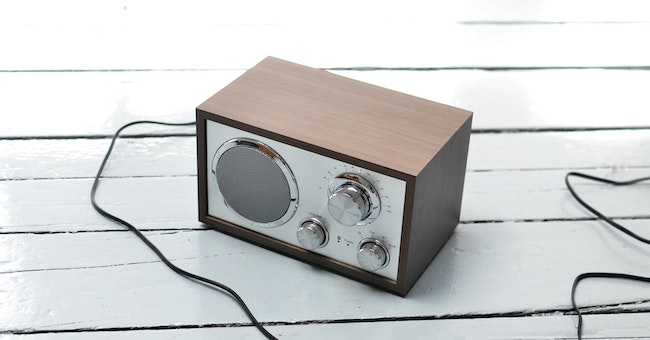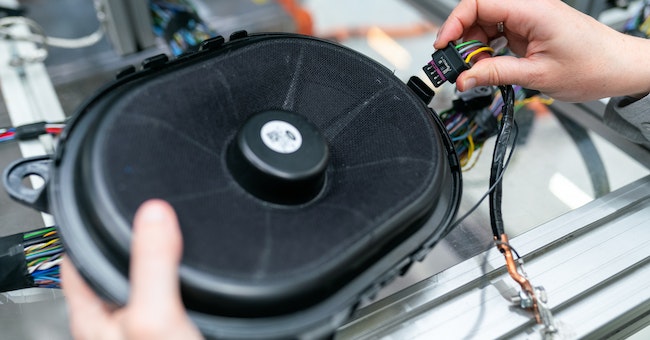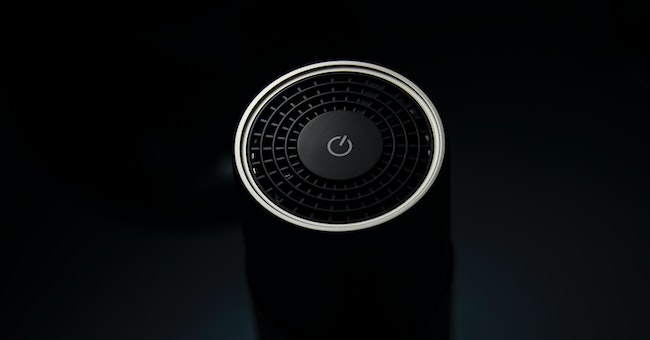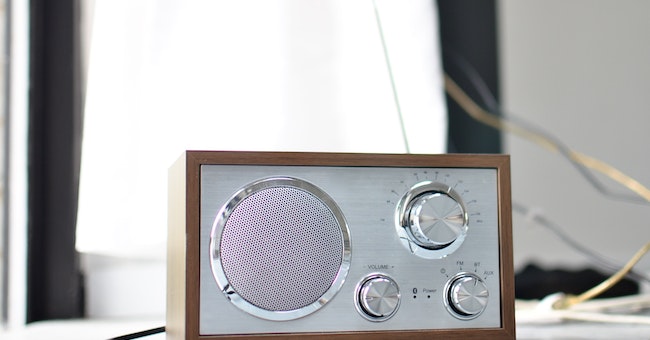How To Hide Speaker Wires On The Wall?
To conceal speaker wires on the wall, use these tips. The first step is determining the route you want the wires to follow. Think about the location of your speakers and the least noticeable route to the wall.
After that, employ a stud finder tool to locate the studs on the wall. This is essential because it can help you avoid damaging structural or electrical components when wiring the wires. Once you’ve found the wires, use a level and pencil to draw an exact line in the area where you’d like the wires to be concealed.
After drawing the line, use a utility knife or drywall saw to cut a small groove along the path you have marked. Be careful that you do not cut too deeply or damage existing electrical wiring.
After that, place the wires for the speaker into the groove, ensuring they are securely inserted inside it. Wire clips or cable channels with adhesive ensure that the wires are well organized and stop them from moving within the groove.
After the wires have been set, apply the joint compound for drywall or spackling paste to cover the groove. Apply the compound using a putty knife, ensuring you smooth it equally. Let the compound dry completely as per the manufacturer’s instructions. After drying, lightly sand it to make a smooth surface.
It is possible to paint the patch to match the wall to finish the job. Choosing similar colors and types is important to ensure an even blend. Make sure not to apply too much paint, as it could expose the hidden wires. Once the paint is dry, your speakers’ wires should be concealed behind the wall, creating an elegant and professional appearance.
When working with electrical equipment or cutting into walls, always be aware and consider seeking advice from a professional if you are unsure of any aspect of the procedure.
Planning The Wire Concealment Process
The process of concealing wires requires a variety of factors to ensure a smooth and efficient installation. Here’s a comprehensive description of the most important factors to take into consideration:
Determine the Route
- Determine the whereabouts of your speakers and find the least noticeable route through the wall to connect the wires.
- Measurements are taken, and you should consider the obstacles like furniture or other items that could affect wiring installation.
- Be aware that the route must be secure and damage-free, for example, drilling into structural or electrical components.
Locate Studs
- Use a stud locater to find the studs within the wall in the desired path.
- Note the locations of the studs by using either a marker or painter’s tape.
- Knowing where the studs are located is essential for later securing cables or wire channels.
Prepare the Wall
- Choose the appropriate level at which you wish your wires to be hidden. Then trace a straight line using an eraser and a level.
- Check that the surface of your wall is free of dirt or other debris before proceeding.
- Remove any wall decorations already in place, including artworks or wall-mounted objects, for ease of covering process.
Create a Groove
- With a utility knife or even a drywall cutter, cut a thin groove on the marked line of the wall.
- Be careful, avoid cutting too deeply, and avoid damaging any electric wiring or pipes buried behind the wall.
- The groove should be large enough to fit the speaker wires with ease.
Install Wire Clips or Cable Channels
- Use wire clips or adhesive cable channels in the groove, ensuring that they hold the wires in place.
- Ensure the channels or clips are properly spaced to avoid excessive tension on wires.
- Connect the clips or channels to the wall, and ensure to align the clips with the designated locations of the studs for extra stability.
Insert and Arrange Wires
- Make sure to connect the speaker’s wires into channel clips or the wires, ensuring they are properly inserted into them.
- Lay out the wires neatly to prevent any tangling and overlaps that can cause audio quality issues.
- Ensure the wires aren’t tightened or bent to prevent all signal interference or loss.
Patch and Finish
- Use a putty knife to apply joint compound to the drywall or spackling paste in the groove, encasing your wires entirely.
- Smooth the compound evenly, creating a smooth finish.
- Let the compound dry by the instructions of the manufacturer before moving on.
Sand and Paint
- After the compound has dried, lightly sand down the patched area to smooth the surface.
- Get rid of any dust or other debris that resulted from sanding.
- Cover the patched area with identical color, and type the wall around it to ensure a seamless blend.
- Apply the paint with care, be careful, and avoid applying too much, which could expose the hidden wires.
Be sure to be cautious during the entire process, and consider getting help from a professional if you have any concerns or questions. The proper planning and execution will yield neat and professional wire concealment for your speakers.
Concealing Speaker Wires In The Wall
Concealing speaker wires in the wall is an elaborate procedure to ensure safety and performance. Here’s a thorough outline of the steps:
Determine Feasibility
- Examine whether it’s possible to hide the speaker wires in the wall.
- Find out if current conduits or wiring routes within the wall could be used to accommodate wires.
- Consider the wall’s construction, like the plaster or drywall, and the possibility of running wires.
Plan the Pathway
- Find the best route within the wall to connect those speaker cables.
- Take into consideration the position of the speakers, as well as the accessibility of wall cavities, as well as possible obstacles like the presence of electrical outlets or pipes.
- Make sure the path is free of possible hazards or obstructions.
Check for Obstructions
- Use a stud locater to find the studs and other obstructions in the wall.
- Note the positions of the studs to ensure they are not damaged when installing the wire.
- Find any electrical wiring, plumbing, or structural elements present, and design the wire path according to the needs.
Cut Access Holes
- Choose where wires will likely come into and out of the wall.
- Use a keyhole, or drywall saw to make access holes in the wall in these places.
- Ensure the holes are big enough to allow for wire connections, and permit an easy installation.
Run the Wires
- Use a flexible fishing wire or wire puller through any holes for access.
- The tool should be guided across the walls, taking note of your planned route.
- Utilize your fish tape to draw the speaker wires across the wall from the point of origin to the final point.
- Be careful not to harm the wires or cause excessive tension.
Make Connections
- Once the wires are drawn through, connect them to the audio source and speakers. Source.
- Remove the wire ends, twist them tightly, and secure them to the correct terminals on the speakers, an audio device, or an amplifier.
Secure and test
- Ensure the wires are set in the wall cavity, and avoid tight kinks or bends.
- Use staples or cable clips to attach the wires to walls studs ensuring they are organized and stopping them from moving.
- Patch the holes into the wall with the drywall compound, sand, and then paint the wall to match the wall.
- Check your speaker to ensure that it’s functioning correctly. Audio transmission and function
It is important to remember that hiding speaker wires in the wall could require assistance from a professional, particularly when you’re new to electrical wiring or wall construction. Consult a qualified electrician or a skilled installer to ensure secure and efficient wiring concealment.
Using Wire Raceways
Covering speaker wires inside the wall is a more intricate procedure to ensure safety and function. Here’s a thorough description of the steps required:
- Step 1: Plan and Prepare Examine the possibility: Find out if hiding the speaker wires inside the wall is feasible. Consider the wall’s construction as well as accessibility and the existing wiring routes.
- Step 2: Pathway Planning: Find the best path within the wall to connect those speaker cables. Be aware of the speaker’s location, walls, and any obstacles that could be in the way, such as plumbing outlets or electrical outlets.
- Step 3: Obstruction Check: Use a stud locater to find electrical wires, studs, or any other obstacles in the wall. Make a note of the location of the studs so that you can ensure they are not damaged in the installation process.
- Step 4: Access Holes: Pick the places in which wires are likely to be able to enter and leave the wall. Use a keyhole, or drywall saw to cautiously make access holes in these spots. Ensure the holes are big enough to allow wire connections and future access.
- Step 5: Wire Installation: Install a flexible fish cable or wire puller through any holes for access. The tool will guide the wall cavity along the route you have planned. Utilize it to push speaker wires into the wall, starting from where you want them to go and ending at the point where they will end.
- Step 6: Connection and Security: After the wires are drawn through, create the connections to the audio and speakers’ sources. Remove the wire end, twist it tightly, and then securely connect it to the proper terminals.
- Secure and arrange the wires: The wires should be arranged neatly inside the wall cavity to avoid tight bends and kinks. Use staples or cable clips to fix the wires onto wall studs, ensuring they stay well organized and stop moving.
- Step 7: Patch and Finish: Make sure you patch access holes on the wall with drywall compound or spackling paste. Smooth the patch evenly and let it dry per the manufacturer’s directions.
- Paint and sand: When the paint is dry and the patch is smooth, lightly sand the areas to make an even surface. Clean up any dust or dirt. Paint the patched areas to match the wall surrounding them, making sure to create an even blend.
- Step 8: Testing: After completing the concealment process, test the system to ensure it is functioning properly. Performance and transmission. Make sure the connections are secure, and resolve any issues that arise.
It is important to remember that hiding speaker wires inside the wall might require a professional’s assistance, particularly if you’re not familiar with electrical wiring or wall construction. Consult a certified electrician or an experienced installer who can ensure that you can carry out safe and reliable wiring concealment.
Hide Speaker Wires By Crown Molding
Covering the speaker wires with crown molding is an attractive alternative. Here’s a comprehensive description of the process:
- Step 1: Measure and Plan Take measurements of your crown’s required length: Make precise measurements of the wall on which you want your crown molding. Calculate how much molding is needed for the complete width.
- Step 2: Select Crown Molding: Think about the design and dimensions of the crown to determine if it is a perfect match for your design. Pick a molding that offers enough space in the back to accommodate speaker wires.
- Step 3: Wire Routing: Choose the best route the speakers’ wires will take on the wall on which the crown molding is installed. Be aware of the position of the speakers as well as any possible obstacles like doors or windows.
- Step 4: Cut Channels: Cut channels into the rear of the molding. Utilize tables, routers, or chisels for creating channels on the back of the crown molding. These channels serve as a route for speaker wires.
- Step 5: Install Crown Molding: Installation of the crown molding: The crown molding should be aligned with the wall, ensuring it covers the wires’ intended path. Fix this molding on the wall with finishing nails or adhesive according to the manufacturer’s instructions.
- Step 6: Run Speaker Wires: The wires should be threaded through the channels. The speaker wires should be inserted into the channels you have created at your crown molding’s back. Make sure the wires are properly placed and secured inside the channels.
- Step 7: Conceal Wires: Ensure the wires are secured within the mold. Use adhesive tape or cable clips to keep the wires inside the channels. Ensure the wires are supported and don’t slide or hinder the molding installation.
- Step 8: Finishing Touches Fill in nail holes and paint. Fill gaps or nail holes in the crown molding using wood putty or filler. Sand the areas to be filled, and then apply stain or paint to match the shade of the molding and the wall surrounding it.
Following the steps below, you can effectively conceal speaker wires using crown molding. It is essential to keep your speakers’ wires securely placed and secured in the channels to maintain an elegant and professional appearance.
Cord Covers And Cable Management Solutions
Cable covers and cord management systems are fantastic alternatives for hiding speaker wires. Here’s a thorough description of the various available options:
Cord Covers
Flexible channels or tubes are made to cover and organize wires on floors or walls. They come in different sizes, materials, and colors that match your interior decor. The steps when making use of cord covers are:
- Measure and make a plan: Find the length of the cord cover needed to cover speaker wires in the desired route. Consider the distance between outlets, speakers, or the audio source.
- Choose cord covers: Select a cover that is suitable for your needs. Think about factors like color, size, material, as well as adaptability in the design of your cover.
- Prepare the space: Make sure the surface of your floor is clean and free of dirt or dust. If necessary, using a level, use a pencil to draw an exact line on which you’d like to put the cover on the cord.
- Install the cover for the cord: Uncover the cover and then insert the speaker wires. Cover it up to secure the wires inside. Utilize mounting brackets or adhesive backing to secure the cover to the floor, wall, or other surfaces.
- Lay out and conceal the wires: Arrange the wires neatly inside the cord cover to prevent tangling and overlap. Utilize adhesive cable ties or tape to keep wires in order and prevent them from shifting within the cover.
Cable Management Solutions
Cable management solutions come with various products that can be used to conceal and organize wires. They comprise cable raceways, cable sleeves, wire ducts, and cable clips. This is a brief overview of the procedures involved:
- Review your requirements: Assess the number and the size of speakers you must hide. Think about the route you will take as well as the obstacles that you have to cross.
- Choose the right option: You should select the right cable management system according to your specific needs. Raceways for cable are channels that may be hung on baseboards or walls.
Wire ducts are channels that can accommodate many wires. Flexible tubes can wrap around wires. Cable clips are clips with adhesive that can be affixed to furniture or walls to keep wires in place. - Measure and plan: Determine the length of the cable management software required to cover the wires that will be used along the path you want to follow. Be aware of any angles or corners that you will need to negotiate.
- Installation of the cable management system: Follow the manufacturer’s directions for installing the selected solution. This usually involves affixing the clips or channels onto your desired surface and running cables through.
- Secure and arrange the wires: Ensure the wires are securely secure within the cable management system. Utilize cable, velcro straps, or zip ties to tie and arrange the wires, stopping them from becoming tangled or messy.
With the help of cover cables or other cable management products, conceal and organize the speaker wires, creating a safer and cleaner space. Follow the manufacturer’s instructions and think about consulting an expert if you’re unsure about a particular step of the procedure.
Wireless Speaker Options
Wireless speakers are a simple and clutter-free way to enjoy audio playback. This is a comprehensive description of the various wireless speaker options:
Bluetooth Speakers
Bluetooth speakers are wireless portable speakers that can be connected to devices such as tablets, smartphones, or laptops via Bluetooth technology. Here are a few important points concerning Bluetooth speakers:
- Accessibility: Bluetooth speakers are compatible with Bluetooth-enabled devices; they can be used with various devices and operating systems.
- The portability: Bluetooth speakers are usually small and battery-powered, which allows users to move them around their home or even take them outside.
- Easy to use: Pairing Bluetooth speakers to your devices is generally simple. Simply turn on your Bluetooth option on your phone, select your speaker in the available list, and establish the connection.
- High-quality audio: Bluetooth speakers are available in various sound qualities and sizes. Certain models have amazing audio performance, whereas others might be limited due to their dimensions and power.
WiFi Speakers
WiFi speakers can connect to your home WiFi network, allowing the streaming of audio wirelessly from many sources. Here are some important points regarding WiFi speakers:
- Connectivity to the network: To operate, WiFi speakers must be connected to a reliable WiFi connection. These speakers are connected to the home network, allowing users to stream music from their devices or streaming online services.
- Audio multi-room: Wi-Fi speakers usually allow multi-room audio, meaning you can play music synchronized across different rooms by connecting multiple speakers with the same wireless network.
- Controlling apps: Wireless speakers are typically equipped with apps for mobile devices that offer greater control over audio playback. These apps let you manage playlists, choose sources, and alter the settings.
- Quality of audio and flexibility: WiFi speakers typically provide higher quality audio when compared to Bluetooth speakers. They can handle higher-resolution audio files and give the most full-bodied listening experience.
Smart Speakers
Smart speakers can combine wireless audio playback, voice control, and smart home features. Here are a few important points regarding smart speakers:
- Controlling your voice: Smart speakers come with virtual assistants such as Amazon Alexa, Google Assistant, and Apple Siri. You can use voice commands to control audio playback, access information, or manage other smart devices within your home.
- Connectivity to smart devices: Smart speakers can be a hub to control other smart home appliances. They can be connected to smart devices like thermostats, lights, or security systems. This allows users to control them using the voice of your own.
- Smart features and streaming services: Smart speakers have built-in support for streaming music services such as Spotify, Apple Music, or Amazon Music. They also offer information on weather, news, and updates and can perform various other tasks using voice commands.
- Quality audio and versatility: Smart speakers have various sizes and audio capabilities. Certain models boast excellent sound quality, whereas others focus on controlling voice and intelligent features over audio quality.
When considering wireless speakers, it is important to assess your specific requirements, like audio quality, portability, and smart home connectivity. This will allow you to choose the wireless speaker that is most suitable for your needs.
Incorporating Speakers Into Wall Art
Incorporating speakers into wall art pieces can be a unique and creative way to integrate audio capabilities while retaining aesthetic appeal. This is a comprehensive outline of the steps:
- Step 1: Choose Suitable Wall Art: Choose artwork with enough space and structure to allow for speakers without damaging the integrity or aesthetics of the artwork. Take into consideration the dimensions, materials, and style of the artwork.
- Step 2: Select Speaker Options: Find small, low-profile speakers that can be easily concealed within wall art. Think about speakers that have high-quality sound while remaining discreet.
- Step 3: Determine Speaker Placement: Examine the wall artwork and determine the ideal location for the speakers. Placed to get the best sound dispersion. Think about the artwork’s size and shape and the desired coverage area.
- Step 4: Create Speaker Openings: Prepare the artwork for the speakers’ installation: Following the speaker’s placement, carefully make cuts or openings in the wall art to fit the speakers. Make sure the openings are of the right size to fit the speakers comfortably.
- Step 5: Mount the Speakers: Install the speakers in the prepared holes and fix them to the wall. Utilize brackets, adhesive, or any other mounting method to ensure the speakers are secured to the artwork.
- Step 6: Conceal Speaker Wires Cover your speaker’s wires. Following the style of your wall art may require hiding those speaker cables. Use cable clips, adhesive channels, or any other cable management solution to conceal the wires on the sides or back of the
- Step 7: Connect and Test Attach the speaker to the source of audio. Make sure your speakers connect to an audio source, like an amplifier, receiver, or wireless transmitter. Follow the manufacturer’s directions to ensure proper connections.
- Step 8: Test and Adjust Examine the audio’s performance: Play music through the speakers and evaluate the audio quality. Adjust the placement of the speakers and equalization or other audio settings to attain the desired balance in sound and sound quality.
Following these steps, you can seamlessly incorporate speakers into your wall art, producing an appealing and functional audio installation. Be sure that the wall art will accommodate the speakers and that the installation process does not harm the artwork. Consider consulting with an expert installation professional if you are uncertain about any aspect of the installation process or require assistance in making customized modifications to your artwork.
Can I hide the speaker wires without the help of a professional?
Yes, you can conceal audio wires without the assistance of a professional. It could require some basic tools and attentive execution. This is a thorough description of the process:
Step 1: Plan the Wire Path
- Find out the path you’d like your wires to travel, considering the position of your speakers and the least noticeable route to the wall.
- Consider measurements and the obstacles like fixtures or furniture that could influence the placement of wires.
- Choose a route that does not cause damage to electrical or structural components.
Step 2: Locate Studs
- Utilize a stud finder tool to find the studs within the wall in the desired path.
- Draw the exact positions of the studs with the marker or painter’s tape.
- Knowing where to place the studs is vital to securely attaching cables or wire clips later.
Step 3: Create Grooves or Channels
- Utilize the utility knife or the drywall saw to cut a narrow groove or channel along the designated line along the wall.
- Be careful not to go too deep or cause damage to any electric wiring or pipes behind the wall.
- The channel or groove must be wide enough to hold the speaker wires easily.
Step 4: Insert and Arrange Wires
- Inject the speaker wires into the channel or groove and ensure they’re securely in it.
- Use wire clips or adhesive cable channels to ensure the wires are neatly organized and prevent them from slipping out of the groove.
- Ensure that the wires aren’t tightened or bent to prevent interference or loss of signal.
Step 5: Patch and Paint
- Use the joint compound for drywall or spackling paste to fill the channel or groove.
- Apply the compound using a putty knife, and smooth it all over.
- Let the mixture completely dry according to the manufacturer’s specifications.
- After drying, lightly sand to smooth the surface.
- Apply paint over the patched areas to coincide with the wall by applying the same paint color and kind.
It is important to remember that even though hiding the speaker wires is possible without a professional’s assistance, it requires certain DIY skills and safety precautions. Be patient, adhere to safety guidelines, and avoid harm or injury. You should speak with an expert for guidance or advice if you’re unsure or have doubts.
FAQ’s
Q: Why is it important to hide speaker wires on the wall?
A: Hiding speaker wires on the wall helps to maintain a clean and clutter-free appearance in your room. It also prevents the wires from becoming tripping hazards and protects them from damage or wear.
Q: What are the options for hiding speaker wires on the wall?
A: There are several options for hiding speaker wires on the wall, including using wire channels or raceways, in-wall cable concealment kits, cord covers, baseboards or crown molding, wire molding, or by running the wires behind furniture or rugs.
Q: How can I hide speaker wires using wire channels or raceways?
A: Wire channels or raceways are plastic or metal tracks that can be attached to the wall. They allow you to conceal the speaker wires within the track, providing a neat and organized look. The channels can be painted to match the wall color for a more seamless appearance.
Q: Can I hide speaker wires inside the wall?
A: Yes, you can hide speaker wires inside the wall by using in-wall cable concealment kits. These kits allow you to run the wires through the wall cavity, providing a clean and hidden installation. It’s recommended to consult a professional or follow local building codes when working with in-wall installations.
Q: How do I hide speaker wires using cord covers or wire molding?
A: Cord covers or wire molding are flexible tubes or tracks that can be mounted on the wall to conceal the speaker wires. You can choose covers that blend with the wall color or paint them to match. They are easy to install and can be removed without damaging the wall if needed.
Q: Are there any tips for hiding speaker wires effectively?
A: Yes, here are some tips: plan the wire routing before installation, use wall studs or anchors for secure mounting, label or color-code the wires for easy identification, and make sure to leave some slack near the speaker connections for future adjustments or repositioning.













